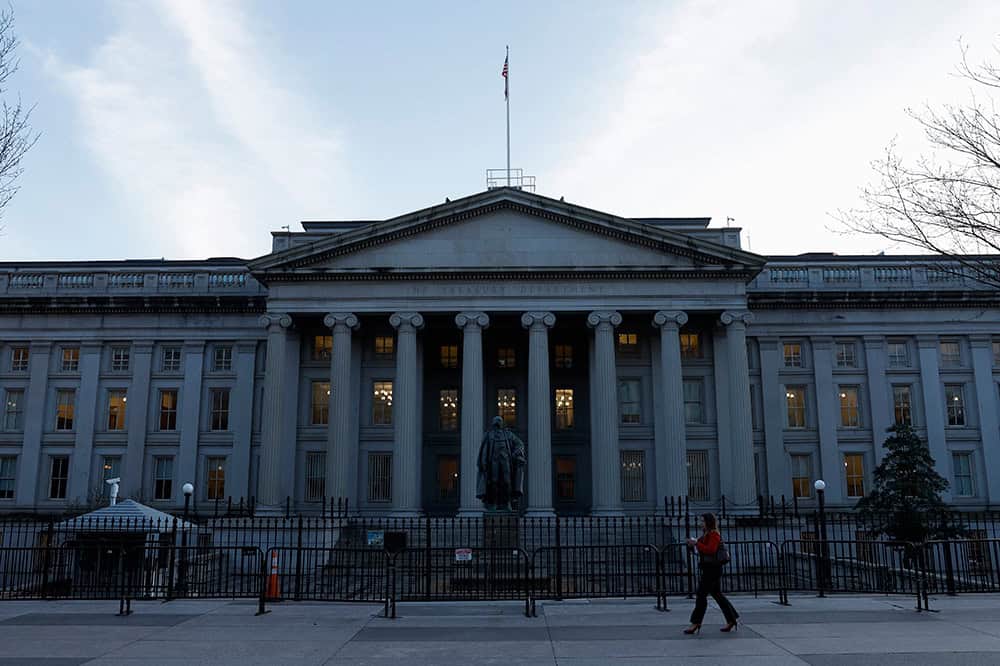New Year’s Resolution: 9 in 10 Voters Say Leaders in Divided Government in 2023 have a Responsibility to Work Together on National Debt
New Polling Shows Strong Majorities Across Party Lines Want Congress and the Administration to Embrace Bipartisan Solutions
NEW YORK (January 5, 2023) — As we enter the new year and an era of divided government, the vast majority of U.S. voters want their leaders to work together on our nation’s unsustainable national debt. With a Democratic administration and Senate, and Republicans controlling the House, voters believe their leaders have a responsibility to find bipartisan solutions to our fiscal and economic future.
Key findings from the polling, which was conducted by a bipartisan team of firms – Global Strategy Group and North Star Opinion Research – include:
- 90% of voters urge Congress members to put election politics aside and embrace a bipartisan approach to reducing the national debt;
- 89% agree that lawmakers in a divided government have the responsibility to work together to address the debt; and
- Three-in-four voters believe that the debt should not be used as a partisan issue.
More broadly, the latest U.S. Fiscal Confidence Index released today ticked down to 43 (100 is neutral), showing heightened voter concern about the debt, which has soared above $31 trillion amid high inflation, rising interest costs and economic uncertainty. The December Index findings include that 83% of voters want the president and Congress to spend more time addressing the debt — tying a 34-month high. Additionally, 76% of voters want the national debt to be a top-three priority for the president and Congress, including 69% of Democrats, 72% of independents and 88% of Republicans.
“Across party lines, vast majorities of voters believe that divided government brings an important responsibility for our leaders to work together to secure our fiscal future,” said Michael A. Peterson, CEO of the Peterson Foundation. “While our nation often seems very divided, the fact that 90% of Americans agree that we should put politics aside and work across the aisle to reduce the national debt is a clear signal to the new Congress as it takes office. As we enter divided government, voters are urging their leaders to fulfill the necessity and responsibility to work together on finding solutions to put our nation on a more sustainable, stable and stronger fiscal and economic path.”
The Fiscal Confidence Index measures public opinion about the national debt by asking six questions in three key areas:
- CONCERN: Level of concern and views about the direction of the national debt.
- PRIORITY: How high a priority addressing the debt should be for elected leaders.
- EXPECTATIONS: Expectations about whether the debt situation will get better or worse in the next few years.
The survey results from these three areas are weighted equally and averaged to produce the Fiscal Confidence Index value. The Fiscal Confidence Index, like the Consumer Confidence Index, is indexed on a scale of 0 to 200, with a neutral midpoint of 100. A reading above 100 indicates positive sentiment. A reading below 100 indicates negative sentiment.
Fiscal Confidence Index Key Data Points:
- The December 2022 Fiscal Confidence Index value is 43. (The November value was 44. The October value was 40.)
- The current Fiscal Confidence Index score for CONCERN about the debt is 36, indicating deep concern about the debt. The score for debt as a PRIORITY that leaders must address is 26, indicating that Americans want elected leaders to make addressing long-term debt a high priority. The score for EXPECTATIONS about progress on the debt is 66. The Fiscal Confidence Index is the average of these three sub-category scores.
- For a description of the complete methodology, see the Appendix below.
The Peter G. Peterson Foundation commissioned this poll by the Global Strategy Group and North Star Opinion Research to survey public opinion on the national debt. The online poll included 1,000 registered voters nationwide, surveyed between December 19, 2022 and December 22, 2022. The poll has a margin of error of +/- 3.1%. The poll examined voters’ opinions on the national debt, political leadership, and America’s fiscal and economic health.
Detailed poll results can be found online at: www.pgpf.org/FiscalConfidenceIndex.
About the Peter G. Peterson Foundation
The Peter G. Peterson Foundation is a nonprofit, nonpartisan organization that is dedicated to increasing public awareness of the nature and urgency of key fiscal challenges threatening America’s future, and to accelerating action on them. To address these challenges successfully, we work to bring Americans together to find and implement sensible, long-term solutions that transcend age, party lines and ideological divides in order to achieve real results. To learn more, please visit www.pgpf.org.
APPENDIX: Fiscal Confidence Index Methodology and Questions
- The Fiscal Confidence Index is released monthly by the Peter G. Peterson Foundation.
- The Fiscal Confidence Index value is based on six questions in three categories.
- As is done with the Consumer Confidence Index, the first step in calculating the Fiscal Confidence Index is determining the “Relative Value” for each question. This calculation is made by taking the positive response for each question and dividing it by the sum of the positive and negative responses. Each question was asked on a four-point scale, and answers were weighted according to intensity, with the strongest responses counting twice as much as the middle responses (“much” better or worse answers count twice as heavily as “somewhat” better or worse answers).
- The scores for the Concern, Priority, and Expectations categories are determined by averaging the scores derived from the two questions in each category.
- The Fiscal Confidence Index value is converted from the Relative Value to place it on a scale on which 100 indicates equal positive and negative sentiment, while values below 100 indicate negative sentiment and values above 100 indicate positive sentiment.
- The questions are as follows:
| CONCERN (36) | |||
|---|---|---|---|
| Thinking about our national debt over the last few years, would you say your level of concern has increased or decreased? ◊ Is that a lot or just a little? |
Dec 2022 | Nov 2022 | Oct 2022 |
| Increased a lot | 51% | 50% | 51% |
| Increased a little | 29% | 28% | 29% |
| Decreased a little | 6% | 7% | 4% |
| Decreased a lot | 3% | 2% | 2% |
| (No change) | 10% | 10% | 10% |
| (Don’t Know/Refused) | 2% | 3% | 3% |
| INCREASED (NET) | 79% | 78% | 80% |
| DECREASED (NET) | 8% | 10% | 7% |
| When it comes to addressing our national debt, would you say things in the United States are heading in the right direction or do you think things are off on the wrong track? ◊ Do you feel that way strongly or just somewhat? |
Dec 2022 | Nov 2022 | Oct 2022 |
| Right direction — Strongly | 10% | 12% | 9% |
| Right direction — Somewhat | 21% | 20% | 19% |
| Wrong track — Somewhat | 27% | 24% | 25% |
| Wrong track — Strongly | 39% | 41% | 43% |
| (Neither/Mixed) | 1% | 1% | 1% |
| (Don’t Know/Refused) | 2% | 2% | 3% |
| RIGHT DIRECTION (NET) | 31% | 32% | 28% |
| WRONG TRACK (NET) | 66% | 65% | 68% |
| PRIORITY (26) | |||
|---|---|---|---|
| Some people say that addressing the national debt should be among the president and Congress’ top 3 priorities. Do you agree or disagree? ◊ Do you feel that way strongly or just somewhat? |
Dec 2022 | Nov 2022 | Oct 2022 |
| Strongly agree | 52% | 51% | 48% |
| Somewhat agree | 24% | 26% | 24% |
| Somewhat disagree | 16% | 16% | 17% |
| Strongly disagree | 5% | 5% | 6% |
| (Don’t Know/Refused) | 4% | 3% | 5% |
| AGREE (NET) | 76% | 77% | 72% |
| DISAGREE (NET) | 20% | 20% | 23% |
| And when it comes to our national debt, do you think it is an issue that the president and Congress should spend more time addressing or less time addressing? ◊ Would you say a lot (more or less) time or just a little? |
Dec 2022 | Nov 2022 | Oct 2022 |
| A lot more time | 49% | 50% | 49% |
| A little more time | 33% | 30% | 30% |
| A little less time | 6% | 6% | 8% |
| A lot less time | 4% | 4% | 3% |
| (The same amount of time) | 3% | 5% | 4% |
| (Don’t Know/Refused) | 4% | 4% | 5% |
| MORE TIME (NET) | 83% | 80% | 79% |
| LESS TIME (NET) | 10% | 11% | 11% |
| EXPECTATIONS (66) | |||
|---|---|---|---|
| And thinking about our national debt over the next few years, do you expect the problem to get better or worse? ◊ Is that much (better or worse) or just somewhat (better or worse)? |
Dec 2022 | Nov 2022 | Oct 2022 |
| Much better | 8% | 8% | 7% |
| Somewhat better | 19% | 21% | 16% |
| Somewhat worse | 30% | 28% | 32% |
| Much worse | 37% | 36% | 38% |
| (No change) | 3% | 3% | 3% |
| (Don’t know/Refused) | 2% | 3% | 5% |
| BETTER (NET) | 28% | 30% | 23% |
| WORSE (NET) | 67% | 64% | 69% |
| And when it comes to our national debt, are you optimistic or pessimistic that the United States will be able to make progress on our national debt over the next few years? ◊ Would you say you are very (optimistic or pessimistic) or just somewhat? |
Dec 2022 | Nov 2022 | Oct 2022 |
| Very optimistic | 7% | 9% | 7% |
| Somewhat optimistic | 35% | 33% | 31% |
| Somewhat pessimistic | 32% | 32% | 35% |
| Very pessimistic | 21% | 20% | 21% |
| (Neither/Mixed) | 2% | 3% | 2% |
| (Don’t Know/Refused) | 3% | 3% | 3% |
| OPTIMISTIC (NET) | 43% | 42% | 38% |
| PESSIMISTIC (NET) | 53% | 53% | 56% |
| As you may know, following the 2022 midterm elections, we will have divided government with Democrats controlling the White House and the U.S. Senate, and Republicans controlling the House of Representatives. For each statement below, please indicate how much you agree or disagree. ◊ In a divided government, lawmakers have a responsibility to work together on priorities like the national debt. |
Dec 2022 | ||
| Strongly Agree | 66% | ||
| Somewhat Agree | 23% | ||
| Somewhat Disagree | 4% | ||
| Strongly Disagree | 3% | ||
| (Don’t Know) | 4% | ||
| AGREE (NET) | 89% | ||
| DISAGREE (NET) | 7% | ||
| ◊ Members of Congress should be willing to put their election politics aside and embrace a bipartisan approach to reducing the national debt. |
Dec 2022 | ||
| Strongly Agree | 59% | ||
| Somewhat Agree | 31% | ||
| Somewhat Disagree | 3% | ||
| Strongly Disagree | 3% | ||
| (Don’t Know) | 4% | ||
| AGREE (NET) | 90% | ||
| DISAGREE (NET) | 6% | ||
| ◊ The national debt shouldn’t be used as a partisan issue. |
Dec 2022 | ||
| Strongly Agree | 48% | ||
| Somewhat Agree | 25% | ||
| Somewhat Disagree | 11% | ||
| Strongly Disagree | 6% | ||
| (Don’t Know) | 10% | ||
| AGREE (NET) | 73% | ||
| DISAGREE (NET) | 17% | ||
Further Reading
Tax Cuts Then and Now: The Debt Is Much Higher
Lawmakers should pursue policies that don’t make our fiscal outlook even worse.
What is a Wealth Tax, and Should the United States Have One?
Proponents of the wealth tax argue that it could help address rising wealth and income inequality while also generating revenues.
News from the Quarterly Treasury Refunding Statement
As borrowing has risen, the Treasury has generally been increasing the proportion of bills (maturity of one year or less) in its portfolio of marketable securities.


